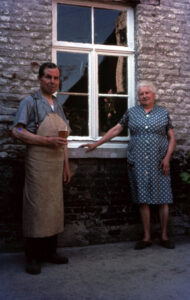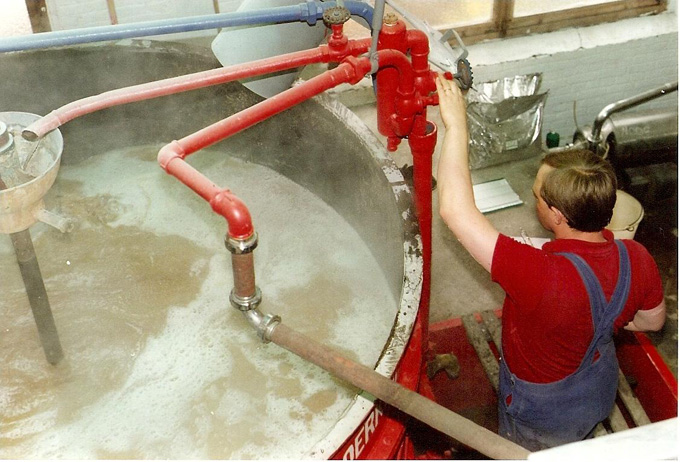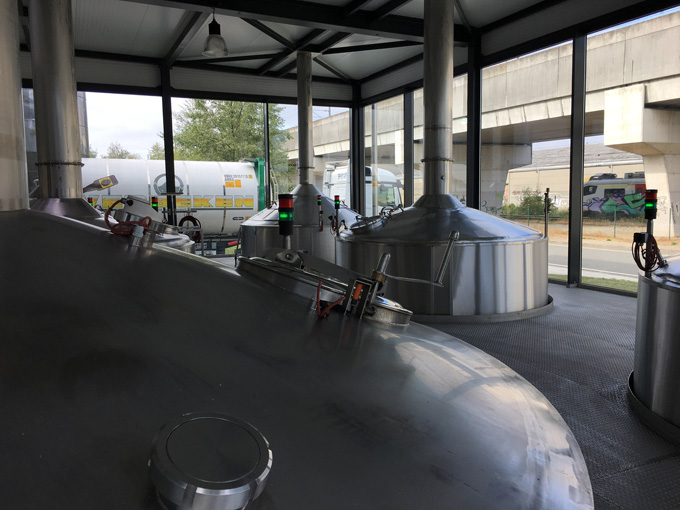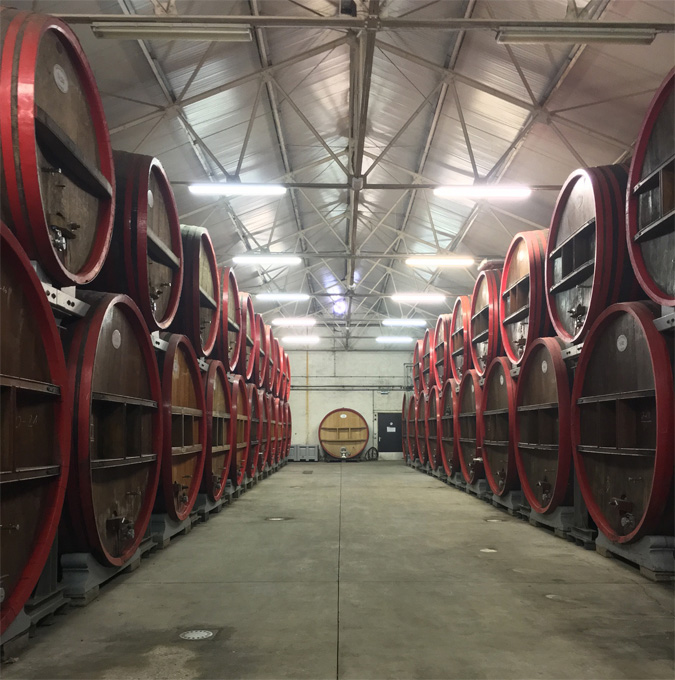Frank Boon’s Early Years
As a child in the 1960s growing up in Belgium, Frank Boon developed an appreciation for complex aromas and tastes thanks to his mother who worked as a culinary journalist. As part of her job, Frank’s mother would try various food recipes and often modified them. She frequently cooked with beer or wine included in the recipe. Regularly she would ask Frank to try the recipe and seek his opinion. At the same time she would educate Frank about different flavors and flavor combinations. Frank’s educated palate would later be channeled in a very specific direction – lambic beer.
Frank also had a Grand Uncle that owned a brewery. Frank enjoyed going there and talking about beer with his uncle. There he learned about different beer styles and his interest in beer grew.
A Life Changing Meeting
When 16, Frank worked with friends during the summer on a farm picking apples. One day at the farm they had a wooden cask of lambic. It came from René De Vits in Lembeek, Belgium. Frank liked the beer and often visited Mr. De Vits’ brewery to buy lambic and geuze. As a result, he got to know René De Vits.
At 18, Frank Boon moved from northern Brussels to Lembeek with his parents. The only person he knew in the area initially was René De Vits. With René De Vits as a mentor, Frank learned the basics of lambic brewing and blending. Frank later said: “He made a fantastic bottle of geuze.” Frank also read numerous books to further his brewing education.
 René De Vits on left side–photograph courtesy of Brouwerij Boon
René De Vits on left side–photograph courtesy of Brouwerij Boon
Shortly thereafter, René De Vits mentioned his plan to close the brewery. Frank expressed interest in acquiring the brewery, but there were two major problems:
- First, the 1970’s anchored the end of a massive decline in lambic brewers and geuze blenders. In fact, in 1970 only 11 breweries and 12 blenders existed as compared to 45 brewers and 120 blenders in 1945. This decline was partially due to lagers gaining popularity with younger Belgians and partially due to the inconsistent production quality among lambic brewers. Lambic and geuze were rapidly headed towards obscurity.
- Second, Frank did not have the funds or financial backing to acquire De Vits’ brewery even though De Vits was only seeking the cost of the buildings.
People thought Frank crazy. But where others saw the looming demise of lambic and geuze, Frank Boon saw opportunity and responsibility. He recognized the opportunity to fill a void in the sales of beer he loved and he embraced the responsibility to revive a Belgian cultural classic.
The Genesis and Evolution of Brouwerij Boon
Frank Boon would not be deterred from his dream of creating lambic. Two months after turning 21 in 1975 (the legal age to start an independent business in Belgium at that time), Frank Boon started a cellar in Halle, Belgium where he blended lambic wort from Lindemans and Girardin. He also started a beer distribution business that promoted beer sales for small, local area Belgian breweries. The goal was to gain experience and enough funds through sales to support a bank loan to buy out René De Vits.
In 1978 Frank realized his goal. He bought the brewery/blendery from René De Vits in Lembeek and renamed it to Brouwerij Boon. From brewing to kegging to blending to bottling and sales, the work was labor intensive. He even made the wire cages that held the cork on each bottle by hand.
 Frank Boon using cast iron mash tun that dates to 1896 – photograph courtesy of Brouwerij Boon
Frank Boon using cast iron mash tun that dates to 1896 – photograph courtesy of Brouwerij Boon
The original location for Brouwerij Boon worked for a time. However as business grew, Frank rapidly realized the existing site lacked adequate water, electricity, plumbing, and most importantly space. Lambic breweries are small companies but they need a lot of space – especially to store and age lambic stock in oak.
Looking to the future, Frank began to search for a new site to house the brewery. However, Frank also realized that it was impossible to develop the brewery further without a financial partner. And in 1985, Frank found a wine merchant partner who joined for a 50% stake in the brewery.
Having secured adequate funding, Frank bought an empty factory complex in Halle in 1986. The factory provided a lot of space – much more than initially needed – and provided room to grow. The site even had a building that Frank converted to his home and raised his family. This site is the current location of Brouwerij Boon.
With the increased space, Frank Boon switched from aging lambic entirely in barrels to primarily foeders (large wooden vats). The brewery’s first foeder was Vat 79, which dates from 1883. Today, this foeder is used exclusively to age 3 year old lambic because its microorganisms have mutated and adapted themselves in a manner that contributes to the character and complexity of the beer.
By 1989, Frank’s wine merchant partner was no longer willing to invest in Brouwerij Boon. Lambic sales were down, but Frank moved forward. Over time, Frank Boon bought back all of the shares of the brewery. However, he realized that he would still need a partner to continue growth. Later on he found that partner in the Palm Brewery group and again sold a 50% stake in the brewery. The stake was transferred to Palm Brewing’s holding company.
In the 1990’s, Frank spearheaded an effort to protect the origin, process, and character of traditional oak-aged lambic. Frank worked with other brewers in the area to establish protections for terms such as “Oude Lambic”, “Oude Geuze” and “Oude Kriek” by the European Union, resulting in assignment of Traditionally Specialty Guaranteed labeling in 1997. At the same time, Frank also worked with other breweries to establish the High Council for Traditional Lambic Beers (HORAL). HORAL is a consortium of lambic brewers and blenders that work together to promote lambic beers, brewing, and culture in Belgium.
In 2004, Frank recognized that much of his second hand equipment, like his cast iron mash tun from 1896, needed replacing. So he started planning for an on-site, modernized brewhouse. Frank’s plan incorporated design elements specifically geared to improve the quality, character and consistency of lambic production.
By 2010 the sales of Oude Geuze experienced a tenfold increase. Still using the old equipment, Frank Boon was struggling to keep up with the pace of sales. And by the end of 2012, Brouwerij Boon was selling more beer than they could brew.
Fortunately, the new brewhouse had started construction in 2011 and completed in 2013. In March 2013, the first lambic was brewed in the new brewhouse, the same month as the last lambic in the old brewhouse. And with its modern brewhouse, Brouwerij Boon created and built up lambic stock at a pace to stay ahead of market demands.
 Modern brewery at Brouwerij Boon
Modern brewery at Brouwerij Boon
Today Brouwerij Boon is the largest producer of traditional lambic beer. With over 150 foeders, Brouwerij Boon has more lambic stock aging in oak than anyone else in the world. Approximately 70 to 75% of Boon’s beers are sold regionally in Belgium.
 A few of the foeders at Brouwerij Boon
A few of the foeders at Brouwerij Boon
Most impressively, Brouwerij Boon has won the World Beer Cup (WBC) Gold Medal in the category “Belgian Style Sour Ale” at every WBC event since 2008. November 2020 will mark 45 years since Frank Boon started his journey as a lambic blender and brewer. Thank you Frank for your vision, your dedication and most of all your great lambic beer.
